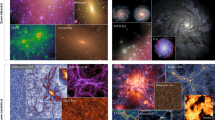Abstract
Convolution methods for modelling of astronomical seeing effects have been investigated. The advantages and disadvantages of several techniques are discussed, and particular attention is given to the fast Fourier transform (FFT) method. This method is then applied to two classes of problems, the structure of cores of elliptical galaxies, appearance of distant galaxies and the consequences of seeing effects in some cosmological tests. Estimates are presented for dimming of the central surface brightness and changes in the apparent core radius for elliptical galaxies, as well as seeing-induced changes in ellipticity. Modelling of galaxies with stellar nuclei has also been performed. Some consequences of these effects in investigations of dynamics of elliptical galaxies are addressed briefly. The influence of seeing in observational cosmology is discussed in the context of Hubble diagram (m-z) tests. It is shown that inadequate compensation for seeing effects can seriously distort the conclusions in such tests. Some suggestions for future work in this direction are offered.
Similar content being viewed by others
References
Bailey, M. E., Sparks, W. B. 1983,Mon. Not. R. astr. Soc.,204, 53p.
Bendinelli, O., Parmeggiani, G., Zavatti, F. 1981, preprint; partly inESO Conference on Scientific Importance of High Angular Resolution at Infrared and Optical Wavelengths, Eds M. H. Ulrich and K. Kjar, ESO, p. 115.
Black, D. (Ed.) 1980,Project Orion, NASA SP4-36.
Bracewell, R. N. 1965,The Fourier Transform and Its Applications, McGrawHill, New York
Brault, J. W., White, O. R. 1971,Astr. Astrophys. 13, 169.
Budinger, T. F., Gulberg, G. T. 1974,Lawrence Berkeley Laboratory report LBL-2146 (TID-4500-R61), University of California, Berkeley.
Caldwell, N. 1983,Astr. J.,88, 804.
Capaccioli, M., Ramapazzo, R. 1980,Mem. Soc. astr. Ital.,51, 491.
Capaccioli, M., de Vaucouleurs, G. 1983,Astrophys. J. Supp L,52, 465.
Connes, J. 1971, inAspen International Conference on Fourier Spectroscopy, Eds G. A. Vanasse, A. T. Stair and D. J. Baker, AFCRL-71-0019 Spec. Rep. No. 114, p. 83.
de Vaucouleurs, G. 1979, inPhotometry, Kinematics and Dynamics of Galaxies, Ed. D. Evans, University of Texas, Austin, p. 1.
de Vaucouleurs, G, Nieto, J.-L. 1979,Astrophys. J.,230, 697.
Djorgovski, S. 1981,Bull. Am. astr. Soc.,13, 796.
Djorgovski, S., Spinrad, H. 1981,Astrophys. J.,251, 417.
Frandsen, S., Thomsen, B. 1979,Astr. Astrophys,72, 111.
Frandsen, S., Thomsen, B.1980, inESOWorkshop on Two-Dimensional Photometry, Eds P. Crane and K. Kjär, ESO, p. 319.
Gunn, J. E, Oke, J. B. 1975,Astrophys. J.,195, 255.
Hoessel, J. G. 1980,Astrophys. J.,241, 493.
Hoessel, J. G., Gunn, J. E., Thuan, T. X. 1980,Astrophys. J.,241, 486.
Hutchings, J. B. 1983, preprint.
King, I. 1966,Astr. J.,71, 64.
King, I. R. 1971,Publ. astr. Soc. Pacific,83, 199.
King, I. R. 1978,Astrophys. J.,222, 1.
Kormendy, J. 1973,Astr. J.,78, 255.
Kron, R. G. 1980,Phys. Scripta,21, 652.
Lauer, T. 1983,Ph.D. thesis, University of California, Santa Cruz.
Moffat, A. 1969,Astr. Astrophys.,3, 455.
Nieto, J.L. 1980, inESO Workshop on Two Dimensional Photometry, Eds P. Crane and K. Kjär, ESO, p.309.
Nieto, J.-L. 1983a,Astr. Astrophys. Suppl. Ser.,53, 247.
Nieto, J.-L. 1983b,Astr. Astrophys. Suppl. Ser.,53, 383.
Oemler, A. 1976,Astrophys. J.,209, 693.
Oppenheim, A. V., Frisk, G. V., Martinez, D. R. 1978,Proc. Inst, electr. electron. Eng.,66, 264.
Peterson, B. M., Collins, G. W. 1983,Astrophys. J.,270, 71.
Pritchet, C, Kline, M. I. 1981,Astr. J.,86, 1859.
Reiger, S. 1963,Astr. J.,68, 395.
Ruiz, M. T. 1976,Astrophys. J,207, 382.
Sandage, A. 1972,Astrophys. J.,173, 485.
Sandage, A. 1973,Astrophys. J.,180, 687.
Sandage, A., Kristian, J., Westphal, J. A. 1976,Astrophys. J.,205, 688.
Schechter, P. 1980,Astr. J.,85, 801.
Schneider, D. P., Gunn, J. E., Hoessel, J. G. 1983,Astrophys. J.,268, 476.
Schweizer, F. 1979,Astrophys. J.,233, 23.
Schweizer, F. 1981,Astr. J.,86, 662.
Siegman, A. E. 1977,Optics Lett.,1, 13.
Su, H. J., Simkin, S. M. 1983,Bull. Am. astr. Soc.,14, 884; and a preprint.
Thomsen, B., Frandsen, S. 1983,Astr. J.,88, 789.
Valdes, F., Jarvis, J., Tyson, J. 1981,Bell Laboratories Technical Memorandum 81-11354-8.
Valdes, F. 1982,Bell Laboratories [Holmdel) preprint 331–44.
Whitmore, B. C. 1980,Astrophys. J.,242, 53.
Woolf, N. J. 1982,Rev. Astr. Astrophys.,20, 367.
Wyckoff, S., Wehinger, P.A., Gehren, T., Fried, J., Spinrad, H., Tapia, S.1983, in24th Liège Coll.: Quasars and Gravitational Lenses (in press).
Young, A. T. 1974,Astrophys. J.,189, 587.
Author information
Authors and Affiliations
Rights and permissions
About this article
Cite this article
Djorgovski, S. Modelling of seeing effects in extragalactic astronomy and cosmology. J. Astrophys. Astr. 4, 271–288 (1983). https://doi.org/10.1007/BF02714921
Received:
Revised:
Issue Date:
DOI: https://doi.org/10.1007/BF02714921




